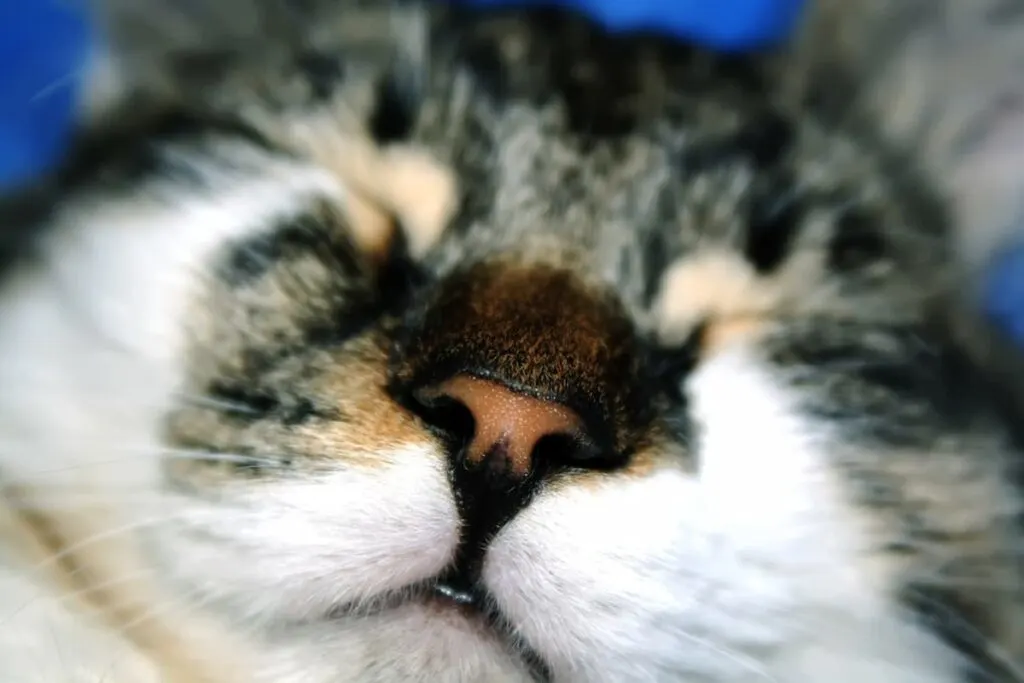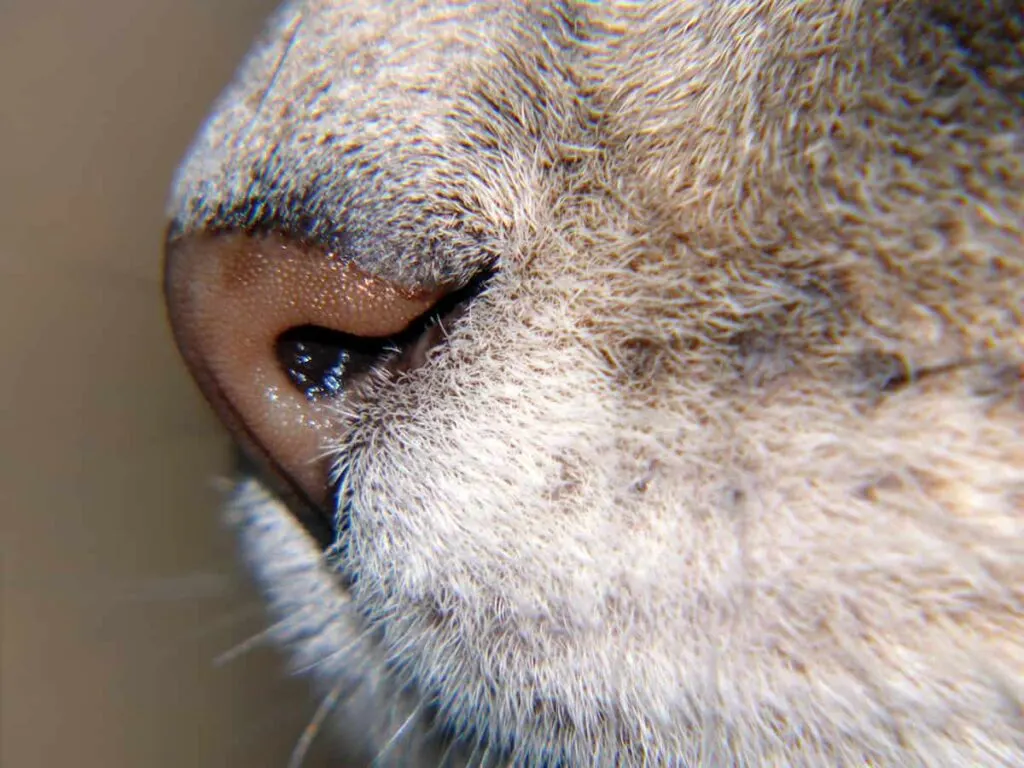A cat’s nose is essential in its anatomy, and any abnormalities may suggest potential medical issues. One such abnormality is the presence of black crust on the nasal area.
Because there are so many causes of this, I thought it’d be best to break it down by natural causes and medical causes so you can better assess what your cat is dealing with.
Let’s get into it!

Causes of Cat Nose Black Crust
A cat’s nose can be a cause for concern when it develops black crust; both medical and natural causes exist. Let’s talk about the natural causes first
Natural Causes
Below are a few natural causes that any cat breed can face when it comes to crust on their nose.
Aging: As cats grow older, their skin may become dry and scaly. At this point, it’ll be common to see black stuff on your cat’s nose, in and around the nostril as well.
Dry Skin: Like humans, felines can suffer from dry skin due to environmental conditions such as low humidity. In this case, the black crust might look like small crumbs on your cat’s nose.
Sunburn: White and light-colored cats are especially prone to incurring sunburns, resulting in the build-up of a black crust on their noses. Prolonged exposure to direct sunlight is what typically causes this issue.
Inadequate Hydration: When cats neglect to drink enough water, it can lead to dry skin and the development of a black crust on their nose. These can appear as black cat boogers, and sometimes they’ll have a weird sticky texture to it.
Medical Causes
Now, we have the medical causes. Some of this is hereditary, and for some cats just poor fortune. Especially when it comes to bacterial causes that can be picked up from playing outdoors.
Fungal Infections: A weakened immune system can often trigger a fungal infection in cats, forming black crust on their noses and other areas of their body.
Aspergillus and Rhizopus are two fungi that commonly cause these infections, with symptoms ranging from itching to discharge. Don’t ignore any signs your cat may be displaying – contact your vet for an accurate diagnosis if you suspect they might have contracted a fungal infection.
Bacterial Infections: Bacterial infections, resulting from various bacteria, including Staphylococcus and Streptococcus, can lead to the formation of black crust along with additional indicators such as redness and discharge.
These bacterial ailments are known to cause a variety of worrisome signs – particularly concerning your nose – which ranges from discoloring it with blackened crusting up to swelling or releasing unwanted secretions.
Allergies: Allergic reactions can leave you scratching and itching, leading to the formation of black crust on your nose. Allergens in food, airborne, or flea bites all spark these allergic responses with symptoms such as a dark layer forming over the nose area, irritation at the affected region, and redness surrounding it.
Cancer: In rare cases, black crust on a cat’s nose can signify cancer. Cancer, a life-threatening disease, can manifest itself in several ways in the body, such as the skin and nasal cavity. Unmistakable symptoms that could indicate cancer are black crusts forming on the nose area, swelling of certain regions, and discharge from these areas.

Diagnosis of Cat Nose Black Crust
To determine the cause of black crust on a cat’s nose, a veterinarian will conduct the following tests:
Physical Examination: During the examination, the veterinarian will carefully inspect the cat’s nose for any swellings, redness, and/or discharges.
Skin Scrapings and Cultures: The vet will collect a sample of the black crust to analyze and identify its root cause.
Blood Tests: To assess your feline friend’s overall well-being and detect potential health issues, the vet may recommend a series of blood tests.
Biopsy: In certain scenarios, a biopsy may be suggested by the veterinarian to verify a diagnosis of cancer.
Symptoms of Cat Nose Black Crust
In addition to a black crust on the feline’s nose, signs of this condition may include dry and flaky skin that is itchy to the touch.
Swelling: The nose may appear swollen and red.
Discharge from the Nose: A foul-smelling discharge, either clear or yellow, may emanate from the feline’s nostrils.
Loss of Appetite: When the cat is in considerable distress or anguish, it may cease its food cravings.
Treatment Options for Cat Nose Black Crust
Depending on the source of your beloved cat’s nose’s black crust, a veterinarian may prescribe one or more of these treatments to help resolve it:
Medications: To address the source of black crust, a physician may prescribe antifungal cream or ointment, antibiotics, and anti-inflammatory medications.
Home Remedies: To help avoid the formation of black crust, regular cleansing and moisturizing your nose will be beneficial.
Surgery: In extreme cases, surgery may be the only option to remove any blackened crust and treat its root cause.
Prevention of Cat Nose Black Crust
To prevent the formation of black crust on a cat’s nose, it is essential to:
Maintain a Healthy Environment: Keep the cat’s living environment clean and free of allergens.
Regular Grooming: Groom the cat regularly to prevent the build-up of dry, flaky skin on the nose.
Monitor Changes in Behavior or Appearance: Keep an eye on the cat’s behavior and appearance, and seek veterinary care if there are any changes.
Feed a Balanced Diet: Feed the cat a balanced diet to maintain their overall health and prevent skin dryness.
When to Seek Veterinary Care
If the black crust doesn’t go away, spreads, or is accompanied by other signs of illness, it is important to seek veterinary care.
Additionally, if your cat is in pain or discomfort, it is essential to seek veterinary care as soon as possible. A veterinarian can diagnose the cause of the black crust and recommend the appropriate treatment.

My name is James, and welcome to FAQCats!
Along with our team of cat owners, expert pet enthusiasts, and pet professionals, we aim to write engaging helpful, engaging content about cats. At FAQCats we strive to provide content that’s accurate and fun to read. Our team writes about everything related to cats; even the most complex of topics. Through extensive research and caring for our own fur-pals, we’re able to provide something cat owners worldwide will love. Have a look around, and leave us feedback anytime!

